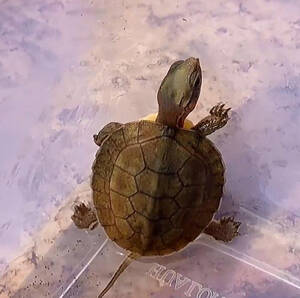Eretmochelys imbricata
IUCN
LCBasic Information
Scientific classification
- name:Eretmochelys imbricata
- Scientific Name:Eretmochelys imbricata, Hawksbill Turtle,Caret, Tortue Caret, Tortue imbriquée, Tortue à bec faucon, Tortue à écailles,Tortuga de Carey,سلحفاة صقرية المنقار
- Outline:Testudines
- Family:Testudinata Cheloniidae Eretmochelys
Vital signs
- length:62.5-114cm
- Weight:35-127kg
- lifetime:1500years
Feature
It likes heat and fears cold, and can live up to 1,500 years, making it one of the longest-lived animals.
Distribution and Habitat
The global distribution range is from 45°N to 38°S. In China, it is distributed from Shandong in the north to the Beibu Gulf and the South China Sea Islands in the south.
It mainly inhabits coastal coral reefs, bays, estuaries and clear lagoons, relatively shallow waters. Nesting usually occurs on remote, isolated beaches.
Appearance
The head is narrow, the carapace is heart-shaped, and there is a longitudinal groove in the center of the abdomen. The whole body is brown, tending to dark brown or tan; the color of the juvenile is brighter than that of the adult, with light yellow or white radial (sometimes cloud-like) spots scattered on the carapace shield; the abdomen is yellow.
Details
Hawksbill turtles are an animal that often migrates. They are highly mobile and swim fast. They are large and fierce carnivorous animals in the ocean and often appear in coral reefs. Hawksbill turtles have strong adaptability and resistance to their prey. Some of the sponges they feed on are highly toxic and often fatal to other organisms. In addition, hawksbill turtles also choose some sponges rich in siliceous spicules as food.

Hawksbill turtles generally live in waters deeper than 18.3 meters, and they live in several habitats with completely different environments during their lifetime. Adult hawksbill turtles mainly live in tropical coral reefs, and during the day they go in and out of many caves and valleys in the coral reefs, which provide them with resting places. As a migratory turtle, they have a variety of habitats, including the vast ocean, lagoons, and even mangrove swamps at the estuary.
Hawksbill turtles like to forage in coral reefs, continental shelves or shallows covered with brown algae. They close their eyes without protective structures when preying on cnidarians, and the stinging cells of highly venomous animals such as aquarium/portuguese-man-of-war.html">Portuguese man-of-war cannot penetrate the scaly head of the hawksbill turtle, so the hawksbill turtle will not be threatened. The hawksbill turtle's jaws are very powerful and can bite crab shells and even extremely hard and thick shells, such as bivalves. The hawksbill turtle's mouth provides convenience for it to prey on shrimps and squids in the crevices of corals, and the eagle-like hooked mouth can easily hook them out.
Hawksbills are omnivores, but their main food is sponges. Sponges make up 70-95% of the total food of Caribbean hawksbills. Hawksbills only feed on a few specific sponge species, such as sponges in the class Demospongiae, especially sponges in the orders Astrophorida, Spirophorida, and Hadromerida. In addition to sponges, the hawksbills' diet also includes seaweed and cnidarians such as jellyfish and anemones. They also prey on the extremely dangerous hydrozoan Physalia physalis. In addition, they also prey on fish, shrimp, crabs, and seaweed.
Among all sea turtles, the hawksbill has some unique features in its body structure and ecological habits, including being the only known reptile that feeds primarily on sponges.

Because hawksbills have unusually strong shells, they have no major predators, as few animals can bite through their shells. Sharks and saltwater crocodiles are considered natural enemies of hawksbills, and octopuses and some surface fish also prey on adult hawksbills. And because hawksbills often forage for sponges, they carry the unpleasant smell of some sponges, and because hawksbills feed on poisonous sponges and cnidarians, their meat contains a considerable level of toxicity, which can sometimes deter some natural enemies or humans.
Although the hawksbill turtle has a long lifespan, grows slowly, has a long reproductive period, matures late, and has a high reproduction rate, and there are many age levels in the hawksbill turtle population, the sharp decline in the number in a short period of time is not easy to be discovered. But in fact, although the reproduction rate of hawksbill turtles is high, like most sea turtles, the survival rate of young turtles is quite low. Many adult sea turtles are killed intentionally or unintentionally by humans, and the nests of sea turtles are also occupied by humans and animals.
Listed in China's "National Key Protected Wildlife List" (February 5, 2021) Level 1.








